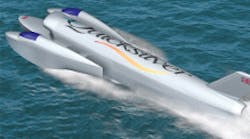Nigel Macknight and his team have been busy finalizing and fine-tuning the design of Quicksilver, the boat in which he plans to set a new world speed record for traveling across the water. (Machine Design covered the start of the Quicksilver project in “Smoke on the Water,” Sept. 28, 2006). “Changes in design were made because we learned more and more about what to do — and what not to do — during the long course of this project’s gestation,” notes Macknight.
One obvious change is that the team moved the air intake for the Rolls-Royce Spey jet engine to a higher point on the craft’s “shoulders.” This should prevent it from ingesting water, a potentially catastrophic event. And the 10,000-hp turbofan now has a 4° nose-up attitude. That’s unconventional in that a nose-up stance could let the engine’s thrust contribute to sending the boat into a nose-up flip. “But a 4° compensatory kink in the jet-pipe ensures that thrust will be parallel to the water line,” explains Macknight.
The stabilizing floats or sponsons were shortened, mainly to save weight. And while the plan was always to have the pilot’s cockpit in the starboard sponson, there’s now talk of making room for an engineer’s seat in the port sponson. The last two-seat World Water Speed Record setter was American Stanley Sayres’ Slo-Mo-Shun, which held the record back in the early 1950s.
Another change involved the tail fin. Its shape is now subsonic, not swept back as in earlier versions. “And we have stuck with our decision not to have a horizontal stabilizer because our wind-tunnel work indicates it can just as likely cause a flip-over accident as prevent one.”
Wind-tunnel testing, which wrapped up just before Christmas, indicates the boat can handle 10° of pitch-up before it flips over backwards. The last British record-holder — Donald Campbell and his boat Bluebird — flipped over in 1967 due to just a 3° nose-up pitch. “We have gained a massive safety margin by moving our center of gravity as far forward as possible,” says Macknight. So with Quicksilver, 70% of the craft’s weight is on the front planing surfaces and just 30% is on the rear. That will make it difficult to get the boat planing at the start of a run, but once it’s on the plane and approaching record speeds it should be rock steady, according to the Quicksilver team.
Another significant change, but one not visible on the outside, is the use of digital controls. On the Quicksilver, the pilot’s steering inputs are relayed by an encoder at the bottom end of the steering column to two compact planetary-gear units, one on each rudder-post (the boat has two rudders). A brushless motor and encoder at the top of each gear unit ensures the rudders’ position matches the position of the steering wheel.
“This is an easily adjustable system,” explains Macknight. “I can alter the steering ratio simply by changing a single number on the dashboard prior to each run, or even during a run. The electric motor at the foot of the steering column is currently passive, but once programmed, it will send artificial-feel responses back to me through the steering wheel. Again, if necessary, these responses can be easily altered to suit the projected speed range of a particular run or my own preferences.”
Adaptability, such as that built into the steering subsystem, is an important requirement to Macknight and his team. “Let’s be clear, until we start building up speed during trial runs on the water, we cannot be sure how Quicksilver will handle,” cautions Macknight. “No matter how many calculations we do, there will still be questions about how much steering input is required in given situations until we start running the boat. Therefore, it’s a real positive to have a steering system that can be tuned to the actual circumstances in which we find ourselves.”
The team is also working on other servo-based subsystems akin to the steering system. The throttle controls, for example, will eliminate the need for a complex mechanical linkage between the pilot’s foot pedal and engine.
